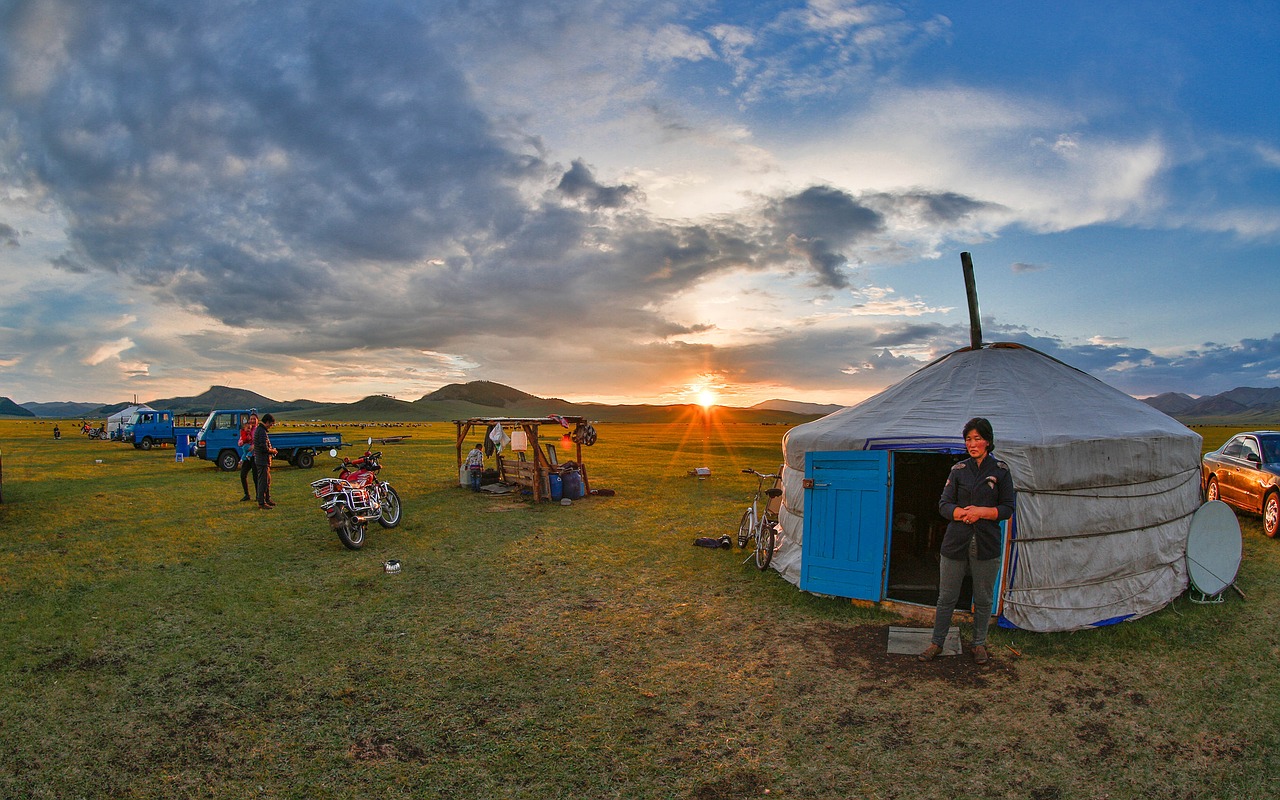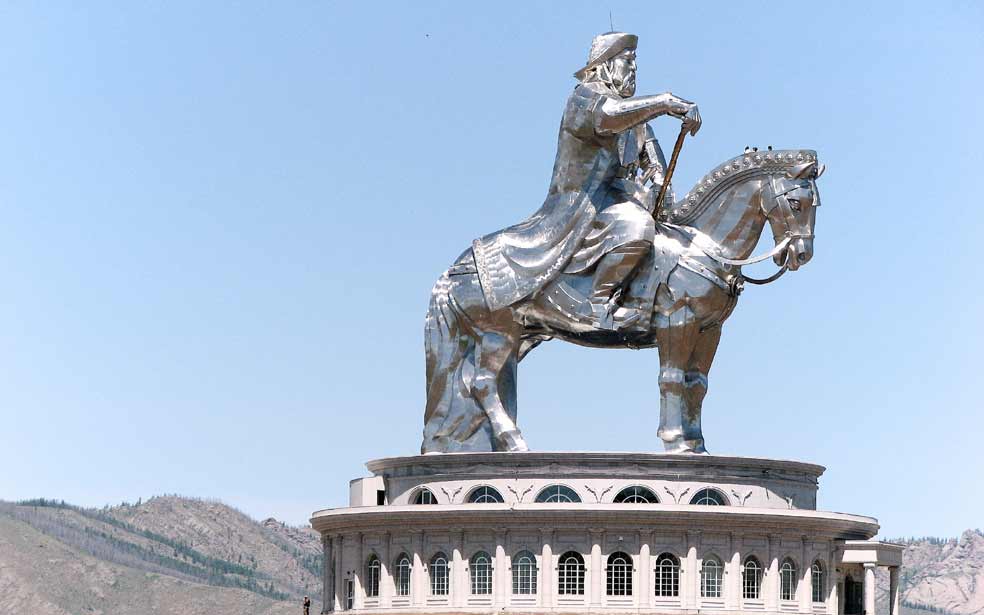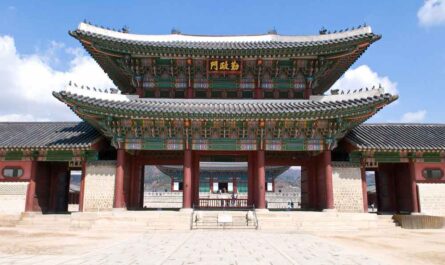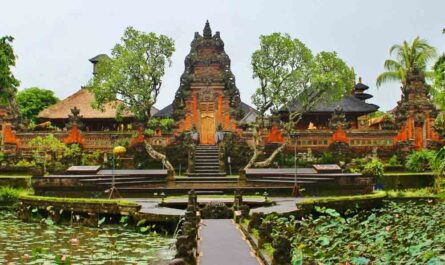There are a lot of interesting facts about Mongolia. Mongolia, nestled between Russia and China, boasts vast steppes, rugged mountains, and the Gobi Desert. The nomadic lifestyle of the Mongolian people is deeply rooted in their geography. Buddhism is the predominant religion, with shamanistic influences, reflected in traditions and festivals. This country has a glorious past and a momentous history of vigor, conquer, and productivity. In this article, I am going to share some of the interesting facts about Mongolia from the list of largest empires in the world.
Interesting Facts about Mongolia: History, Travel, Culture
Distinctive customs and dress reflect both nomadic heritage and contemporary influences. Visitors can savor traditional Mongolian cuisine, including hearty meat-based dishes, and experience lively festivals like Naadam, showcasing the “Three Manly Games” of wrestling, horse racing, and archery. The country’s attractions range from the iconic Genghis Khan Equestrian Statue to the stunning landscapes of Terelj National Park. Let’s find below some interesting facts about Mongolia:
1. Guinness World Record for Wrestling Competitors
Mongolia, a vast expanse of rugged terrain and nomadic traditions, proudly boasts a distinctive accolade in the realm of sports—the Guinness World Record for hosting the most significant wrestling competition on the planet. This illustrious achievement was realized during the Mongolian National Wrestling Match in the year 2011. The event, marked by fervor and athleticism, solidified Mongolia’s presence on the global stage of traditional sportsmanship.
2. Handbag Symbolism in Mongolia
In the vast and culturally rich landscapes of Mongolia, the term “handbag” takes on a unique and symbolic meaning. Far from the conventional Western interpretation, here, a handbag transcends its material form, manifesting as a delicate silk scarf. These scarves, typically adorned in hues of white, blue, gold, and orange, serve a dual purpose. Firstly, they are proffered as a profound gesture of respect, reserved for high-ranking individuals or revered spiritual leaders. Secondly, these silk handbags find a sacred place as offerings within the contemplative walls of Lamaist temples, further weaving the tapestry of Mongolia’s intricate cultural practices.
3. Diverse Ethnic Tapestry
Mongolia, with its expansive steppes and nomadic traditions, boasts a population with a fascinating ethnic composition. The predominant group, constituting 94.9% of the populace, is the Mongol ethnicity, predominantly of the Khalkha lineage. Adding a vibrant layer of diversity, 5% of the population identifies with Turkic roots, with Kazaks emerging as the most prominent subgroup within this category. The remaining 0.1% represents a mosaic of various ethnicities, including Chinese and Russian influences. This dynamic ethnic tapestry mirrors the historical interactions and migrations that have shaped Mongolia’s cultural identity.
4. Religious Mosaic
Religion in Mongolia paints a diverse and nuanced picture, reflecting the convergence of different belief systems. The majority, encompassing 53% of the population, adheres to the Buddhist Lamaist tradition, an integral part of Mongolian spirituality. Islam finds its place among 3%, Christianity among 2.2%, and Shamanism among 2.9% of the populace. A further 0.4% ascribes to other faiths, embodying a kaleidoscope of religious expressions. Notably, a substantial portion—38.6%—chooses a secular path, embracing no formal religious affiliation as of the 2010 estimates. This religious mosaic showcases the coexistence and synthesis of diverse spiritual legacies within Mongolia’s social fabric.
5. Mongolia’s Bounty of Natural Resources
Beneath the expansive steppes and sprawling landscapes, Mongolia conceals a treasure trove of natural resources. The nation’s geological embrace holds reserves of oil, copper, molybdenum, tungsten, phosphates, tin, nickel, zinc, wolfram, fluorspar, gold, silver, and iron. This wealth beneath the surface not only signifies economic potential but also shapes the geopolitical landscape of the region. Mongolia’s mineral wealth, akin to its cultural wealth, adds a layer of complexity to the nation’s narrative, intertwining economic pursuits with the preservation of its unique heritage.
6. Mongol Khuumii: The Art of Throat Singing
Delving into the cultural tapestry of Mongolia unveils a captivating musical tradition known as Mongol Khuumii, a phenomenon commonly recognized as throat singing. This extraordinary practice involves the intricate art of producing two simultaneous tones with the human voice, creating a harmonious blend of sounds that resonate with the vast landscapes of the Mongolian steppes. Mongol Khuumii stands as a testament to the unique and multifaceted cultural heritage embedded within the heart of Mongolia.
7. Bökh: The Pinnacle of Mongolian Sport
At the epicenter of Mongolian athleticism lies bökh, a sport synonymous with sturdiness and resilience. This form of wrestling takes center stage during Mongolia’s Independence Day celebration, where competitors vie for honor and distinction. The stakes are high, as the first-place victor earns the esteemed right to be called “arslan” or lion. The runner-up assumes the title of “dzan” or elephant, while the third-place finisher is crowned “nachin” or eagle. A remarkable aspect of Mongol wrestling is the elusive title of “avrag” or titan, reserved for the Arslan who conquers the event twice in succession—an achievement akin to the Grand Champion rank in Japanese sumo wrestling.
8. Jügderdemidiin Gürragchaa’s Historic Journey into Space
Jügderdemidiin Gürragchaa etched his name into the annals of history as the inaugural Mongolian to venture into space. This momentous event unfolded on March 1, 1978, when he joined the ranks of the eighth Intercosmos program. Gürragchaa’s celestial odyssey saw him spend an impressive 7 days, 20 hours, and 42 minutes aboard the Salyut 6 space station, marking a pioneering achievement for both Mongolia and the global space exploration community.
9. The Inauguration of Mongolia’s First Lodge – Ulaanbaatar Hotel
A pivotal milestone in Mongolia’s modern history unfolded with the grand opening of the Ulaanbaatar Hotel in 1961. This establishment not only claimed the title of being the nation’s premier lodge but also held the distinction of being the first public building to boast the luxury of both hot and cold running water. The Ulaanbaatar Hotel stands as a symbol of Mongolia’s progress and modernization, offering a glimpse into the transformative changes that began to shape the country.
10. Mongolia’s Capital and Population Distribution
Almost half of Mongolia’s entire population is concentrated in its bustling capital metropolis, Ulaanbaatar. The gravitational pull of urban life draws people from diverse backgrounds, creating a dynamic and vibrant tapestry within this cityscape. Amidst the sprawling architecture and the pulsating energy, Ulaanbaatar becomes a microcosm of Mongolian society, where traditions seamlessly blend with the modern rhythms of everyday life, worth traveling.
11. Genghis Khan: A Timeless Political Icon
Mongolia, a nation steeped in a rich tapestry of history, proudly claims Genghis Khan as a cultural and historical luminary. The indomitable Mongolian warlord achieved a remarkable posthumous accolade in 2011 when he was elected as one of Time magazine’s “25 Most Important Political Icons of All Time.” This recognition not only echoes the enduring impact of Genghis Khan but also underscores his influence on the global political landscape.
12. Mongolia’s Diverse Landscape and Abundance of Salt Lakes
Despite being landlocked, Mongolia boasts a surprising feature—numerous salt lakes dotting its expansive terrain. These natural wonders tucked away amidst the vastness of the country, add an unexpected element to Mongolia’s geographic profile. These lakes, diverse in size and character, contribute to the country’s ecological richness, fostering a unique environment that stands in contrast to its landlocked status.
13. Mongolia’s Impressive Geographical Magnitude and Sparse Population
Nestled within the vast expanse of Asia, Mongolia proudly holds the title of the seventh-largest nation on the continent and the 19th-largest globally. However, what truly sets Mongolia apart is not just its sheer size but its remarkable sparsity in population, ranking as the third most sparsely populated country on Earth. The Mongolian landscape unfolds as a tapestry dominated by sweeping steppes, expansive deserts, and semi-desert regions. An astonishing 75% of this colossal landmass is designated for the essential activity of livestock grazing.
14. Mongolia’s Historic Bogd Khan National Park
Mongolia boasts the distinction of harboring the world’s oldest national park, a pristine testament to nature’s longevity. Nestled just to the south of Ulaanbaatar, the Bogd Khan National Park traces its roots back to the year 1778, a remarkable genesis that predates the renowned Yellowstone National Park by a staggering century. This emerald expanse unfolds a narrative of ecological heritage, chronicling the passage of time with its ancient landscapes and diverse ecosystems. The park, with its rich tapestry of flora and fauna, stands as a living relic, a canvas where history and nature entwine in a dance that spans centuries.
15. Demographic Mosaic: Mongolia’s Youthful Population
In the demographic mosaic of Mongolia, a striking facet emerges – a vibrant tapestry where thirty-six percent of the nation’s inhabitants find themselves beneath the age of 18. This youthful surge pulses through the heart of Mongolia, painting a portrait of energy and potential. The country’s future unfolds against the backdrop of this youthful exuberance, a demographic force that shapes the dynamics of society, education, and cultural evolution. Mongolia’s identity is, in part, sculpted by the dreams and aspirations of its younger generation, a testament to the nation’s ongoing journey through time.
16. The Spiritual Tapestry: Lamaism in Mongolia
At the spiritual crossroads of Mongolia, the dominant faith unfurls in the form of Lamaism, the Yellow sect of Tibetan Buddhism. This spiritual tapestry traces its origins to Tibet in the 7th century A.D., but it found its fervent embrace in Mongolia during the 16th century, courtesy of the visionary Mongolian ruler Altan Khan. Not only did Altan Khan introduce Lamaism to the Mongolian masses, but he also bestowed the prestigious title of Dalai Lama upon Tibet’s spiritual leader. The interweaving of Tibetan Buddhism with Mongolia’s cultural fabric adds a layer of transcendental significance to the nation’s ethos.
17. Culinary Ingenuity: The Ice Cream Saga of Mongolian Horsemen
In the annals of culinary history, an intriguing tale emerges from the vast expanse of the Gobi desert, where Mongolian horsemen, traversing the winter landscape, may have unwittingly invented ice cream. The narrative unfolds with cream stored in containers fashioned from animal intestines, serving as provisions during the arduous journeys. As the horsemen galloped, the cream, confined within its unique casing, experienced a vigorous shaking.
The sub-zero temperatures of the Gobi desert, acting as a culinary alchemist, caused the cream to freeze. This accidental creation, borne out of the nomadic spirit and harsh climate, may have led to the propagation of ice cream. The ripple effect of the Mongol Empire’s expansion carried this frozen delicacy through China, and it is said that Marco Polo, on his return from his travels in 1295, introduced the concept of ice cream to Italy, a gift from the nomadic winds of Mongolia.

18. Nomadic Livestock Herding in Mongolia
Mongolian nomads, deeply connected to their ancestral traditions, engage in the herding of a remarkable array of livestock. The pastoral scene is composed of horses, camels, sheep, goats, and cows (with the interesting inclusion of yak, considered as a type of cow). The sheer magnitude of Mongolia’s livestock population is staggering, reaching an impressive 71 million—a staggering 22 times larger than the country’s human inhabitants. This intricate balance between human and animal life forms the backbone of Mongolia’s cultural identity and sustains its age-old nomadic way of life.
19. Mongolia’s Unique Demographic Quirk
Adding to its roster of superlatives, Mongolia proudly holds the distinction of being the world’s least populated nation. This demographic quirk further underscores the vast expanses of untouched wilderness that define the Mongolian landscape. Amidst the vast steppes and sweeping deserts, the sparse population of Mongolia becomes a defining feature, shaping the nation’s identity and influencing its cultural tapestry in ways both subtle and profound.
20. The Jurassic Unveiling in Mongolia’s Gobi Desert
In the annals of paleontology, the Gobi Desert in Mongolia stands as a treasure trove of ancient secrets. In the year 1922, the curtain of time was pulled back by the intrepid American explorer Roy Chapman Andrews. Venturing into the heart of the Gobi, Andrews became the first human to unearth dinosaur bones from the Cretaceous period, unlocking a prehistoric narrative etched in the sands of Mongolia. Legend has it that Andrews’ daring exploits in the Gobi served as the muse for the iconic film character Indiana Jones.
21. The Historical Tapestry of the Title “Mongol”
Delving into the historical fabric of Mongolia, the title “Mongol” emerges as a narrative thread that weaves through the epochs. Recorded for the first time during China’s T’ang Dynasty (A.D. 618–907), the term “Mongol” carries with it echoes of a bygone era. In a complex interplay of alliances and conquests, the Uyghurs, now inhabitants of China’s Xinjiang province, joined forces with the T’ang. This strategic alliance culminated in the invasion of Mongolia in 744, leading to the Uyghurs’ dominance over the region until the year 840. The historical ebb and flow of power unfold like chapters in a captivating saga, with Mongolia at the center of a geopolitical narrative.
22. Mongolian Linguistic Tapestry in the Ural-Altaic Family
Mongolian, a linguistic gem, finds itself nestled within the diverse Ural-Altaic family of languages. This linguistic kinship extends to a fascinating array of languages, including Finnish, Turkish, Kazakh, Uzbek, and Korean among its relatives. The rich tapestry of the Ural-Altaic family underscores the linguistic diversity that Mongolia contributes to the global mosaic, intertwining threads of communication across different cultures and regions.
23. Snow Leopards in Mongolia
Mongolia, a vast and captivating country, cradles one-third of the world’s snow leopard population. These elusive and majestic creatures find refuge in the rugged landscapes of Mongolia, where they navigate the challenging terrain with unmatched grace. The stark beauty of the Mongolian mountains and plateaus provides a unique habitat for these endangered big cats, contributing to the global conservation effort for this remarkable species.
24. Mongolian Hospitality Tradition
The tradition of hospitality runs deep in the veins of the Mongolian people, and their unique way of welcoming guests is a testament to their cultural richness. When visitors arrive, they are often greeted with a gesture that goes beyond mere words—the presentation of a bowl filled with ‘airag.’ This traditional beverage, derived from fermented horse milk, serves as a symbolic offering, embodying the warmth and generosity ingrained in Mongolian hospitality. To decline a cup of ‘airag’ is not merely a refusal; it is considered a breach of respect for the age-old customs that define Mongolian social interactions.
25. Genghis Khan: Enduring Literary Triumph
Harold Lamb’s literary masterpiece, “Genghis Khan: Emperor of All Men,” published in 1927, remains an unparalleled triumph in the realm of biographical literature. Lamb skillfully navigates the intricate corridors of history, capturing the essence of the Mongolian warlord’s life with a narrative prowess that has withstood the test of time. The book’s continued status as a bestseller attests to its enduring appeal and the author’s ability to weave a captivating tale of power, conquest, and the enigmatic persona of Genghis Khan.
26. Mongolia’s Diplomatic Milestone: Joining the United Nations
In the annals of diplomatic history, Mongolia etched a notable chapter in 1961 by becoming a member of the United Nations (UN). This milestone not only reflects the nation’s geopolitical evolution but also underscores its commitment to international cooperation and diplomacy. The intriguing fact that Mongolia, with its rich cultural heritage and nomadic traditions, took its place on the global stage adds a layer of complexity to the tapestry of nations within the UN, showcasing the diversity and inclusivity that characterizes this esteemed international organization.
27. Nomadic Life in Modern Mongolia
In the heart of Mongolia, a significant percentage of the population clings to a lifestyle that transcends time—nomadic living. Astonishingly, approximately 25-40% of Mongolians have resisted the tide of modernity, choosing to uphold the nomadic traditions that have defined their heritage for centuries. These individuals, often dwelling in traditional felt tents known as ‘gers,’ traverse the vast expanses of the Mongolian steppes, embodying a way of life that remains both resilient and deeply rooted in the country’s cultural identity. This enduring connection to nomadism adds a layer of intrigue to Mongolia’s contemporary landscape, showcasing the harmonious coexistence of tradition and modernity.
28. The Equine Abundance of Mongolia
In the vast expanses of Mongolia, a statistic emerges that captures the essence of the nomadic lifestyle ingrained in its heritage. Astonishingly, the number of horses galloping across the Mongolian landscape surpasses the human population by a staggering factor of thirteen. This revelation not only unveils a numerical quirk but also serves as a testament to the enduring connection between the Mongolian people and their equestrian companions. The prevalence of horses not only accentuates the nomadic spirit but also underscores the integral role these animals play in the cultural and historical tapestry of Mongolia.
29. Diplomacy and Identity: Mongolia and Taiwan
The diplomatic landscape underwent a significant shift in 2002 when Taiwan officially acknowledged Mongolia as an autonomous nation, leading to its removal from maps of China. Paradoxically, Mongolia continues to align itself with the “One-China Policy,” formally recognizing Taiwan as an integral part of China. This diplomatic intricacy highlights the delicate balance that nations navigate in their pursuit of international recognition and alliances. Mongolia’s dual stance reflects the complex interplay of geopolitics and identity, where formal acknowledgments may not always align seamlessly with geopolitical realities.
30. Mongolia’s Diplomatic Journey to the United Nations
In 1961, Mongolia embarked on a significant diplomatic journey by gaining admission to the prestigious United Nations. This move signaled the country’s desire to actively participate in the international community and engage in global affairs. However, the road to recognition was not without its challenges. Remarkably, it wasn’t until 1987 that the United States of America, alongside a cohort of 100 other nations, formally acknowledged Mongolia as a sovereign nation. This delayed recognition adds a nuanced layer to Mongolia’s diplomatic history, highlighting the complexities of global politics.
31. Soyombo’s Legacy: Mongolia’s Post-Revolutionary Seals
In the aftermath of the 1921 Revolution, a pivotal moment in Mongolia’s socio-political landscape, the government undertook the creation of seals. Drawing inspiration from the Soyombo, a national symbol imbued with profound cultural significance, these seals became emblematic of Mongolia’s newfound identity. The Soyombo, with its intricate symbolism representing fire, sun, moon, earth, and water, encapsulated the essence of a nation forging its path in the crucible of change. These seals, adorned with the Soyombo, served as more than bureaucratic insignias; they became visual narratives echoing the resilience and adaptability of Mongolian culture.
32. Political Structure in Mongolia
Presidential and Parliamentary elections occur once every four years in Mongolia, reflecting the nation’s commitment to democratic governance. Notably, these elections are distinct events, allowing citizens to cast their votes for both the head of state and the parliamentary representatives separately. Mongolia, proudly embracing democratic ideals, operates under a parliamentary system, showcasing the country’s dedication to fostering political pluralism and civic participation.
33. Harmonic Tunes in Mongolian Culture
Delving into the rich tapestry of Mongolian culture, music emerges as a vital and resonant thread. The significance of music goes beyond mere entertainment; it serves as a powerful means of expressing emotions tied to nature, the expansive landscapes, the revered horses, and the profound bonds within families. This auditory heritage, steeped in tradition, encapsulates the soulful essence of Mongolia’s cultural identity, harmonizing with the natural rhythms of life on the vast steppes. Motivation – Mind – Success – Thinking – Productivity – Happiness
34. The Nomadic Rhythm of Ulaanbaatar
Ulaanbaatar, with a population of 949,000, stands as the beating heart and vibrant capital of Mongolia. Intriguingly, this metropolis, deeply rooted in nomadic traditions, once traversed the vast landscapes three times annually. The name itself, “Ulaanbaatar,” translates to “Red Hero,” a fitting epithet for a city that reflects the courage and spirit of its inhabitants. A captivating detail lies just beyond the city limits: a colossal 131-foot statue of Genghis Khan graces the steppe, a mere hour’s drive from Ulaanbaatar, symbolizing the enduring legacy of Mongolia’s iconic leader.
35. Tamga in Pastoral Life: Livestock Brands as Cultural Signifiers
Beyond the corridors of power and the annals of history, the term “tamga” finds resonance in the vast expanse of Mongolia’s pastoral landscapes. Here, among nomadic herders, “tamga” takes on a practical yet culturally resonant role as livestock brands. In the sweeping steppes, these imprints on animals not only signify ownership but also weave a tapestry of familial and communal ties. Each tamga becomes a visual ode to a herder’s connection with the land, an intimate marker in the sprawling canvas of Mongolia’s cultural mosaic—a living testament to the enduring bond between the people and their pastoral heritage.
36. Wrestling: An Ancient Mongolian Tradition
Wrestling, deeply entrenched in the fabric of Mongolian society, is not merely a sport but a time-honored tradition with roots stretching back centuries, possibly beyond recorded history. Accounts from Chinese visitors in the seventh century A.D. speak of witnessing wrestling matches on Mongolian soil, underscoring the enduring nature of this athletic pursuit. The chronicle of the Franciscan friar Carpini, who found himself amidst the bustling Mongol capital of Karakoram in the 13th century, further attests to the longevity of Mongolian wrestling. It is a testament to the resilience of tradition and the enduring spirit that has characterized Mongolian wrestling through the ages.
More Interesting Articles
- 30 Interesting Facts about Abu Dhabi Tourism
- 20 Interesting Switzerland Facts One Should Know
- 26 Interesting Great Pyramid of Giza Facts
- 12 Persian Empire Facts and Achievements
- El Salvador History – How the Country Moves On
- History of Latin America – Twists and Thrills
- Spanish Colonization of the Americas
- The United States in Order of Statehood
- Dumb Laws in the US You Should Know Before Travel
- British National Museum Tourists Guide with Time Table
- British History Museum Collection Tourist Guide
- 81 Interesting Facts about Singapore
- British War Museum Stands with a Glorious Past
- 130 Facts of El Salvador Everyone Should Know
- 52 Interesting Fun Facts about New Mexico, USA
- 200 Interesting Facts About Thailand
- Jollof Rice Recipe for Nigerian – Taste, and Preparation



